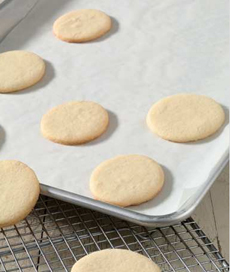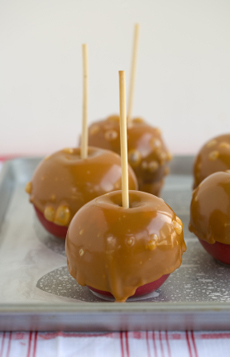August 18, 2013 at 8:43 am
· Filed under Cookies-Cake-Pastry, Kitchenware-Tabletop, Tip Of The Day

Cookies on parchment paper. Photo courtesy
King Arthur. |
|
We’ve gotten a few inquiries about waxed paper versus parchment paper. The easiest way to remember which to use is that wax melts when it’s near heat. So:
Parchment paper can take the heat. It’s thinly coated with silicone, which is nonstick and heat-resistant. It’s nonstick, which is why it is recommended to line cookie sheets and pans. It costs more than wax paper, but is more versatile.
Waxed paper can’t take the heat. The soybean or paraffin wax surface will melt and can even catch fire! The paper is coated with a thin-layer of food-safe wax, which keeps the food from sticking. You can use wax paper to line pans, as long as the wax paper is completely covered by the food. Otherwise, the wax will melt, and the paper will smoke and burn.
For some tasks you can use either.
WHEN TO USE PARCHMENT PAPER
Baking. Most brands can withstand temperatures up to 420°F for up to 30 minutes. (For higher-heat and longer baking, check the package to be sure.) Popular uses include lining cookie sheets instead of greasing them. This also keeps grease from fragile cookies like meringues.
|
|
Cooking. The most popular use is “en papillote,” a technique of wrapping food in a pouch of parchment paper before baking. It locks in flavor and keeps the moisture in as it steams the fish and other foods—a low calorie preparation. You can also microwave leftover pizza on a piece of parchment to help crisp the bottom.
Lining. The elegant-looking parchment can be used instead of a napkin.
Serving. Restaurants use it to present cones of French fries and other fried foods. You can also use it to serve popcorn and other snacks. Use a piece of tape to seal the cone.
Don’t use parchment in the broiler: It can catch fire. Use foil instead.
Parchment paper can be purchased in rolls or in precut sheets that fit different size baking pans. There are two “grades”: the original silicon-treated parchment and a newer, much cheaper variety treated with Quilon. The Quilon parchment has a lower heat tolerance, but is fine for most baking needs.
Some bakers use Silpat: washable, reusable silicon pan liners. They’re great for some needs, but don’t give cookies the crispiness they need on the bottom.
|
|
WHEN TO USE WAXED PAPER
Wax paper was designed to repel moisture. It was first invented to keep bags of potato chips from getting soggy.
Covering. When slicing raw meats, lay a sheet of wax paper atop the cutting board to keep the surface sanitary.
Lining. Line the produce drawers of the fridge, and you won’t have to remove and wash the entire bin as often. Similarly, you can use it to line kitchen drawers.
Mixing. Here’s a baking tip: Mix the dry ingredients on a sheet of wax paper on the counter. Lift it to form a funnel and easily transfer the ingredients into the mixer bowl.
Dustbuster. Mom’s favorite use: Place wax paper on top of the upper kitchen cabinets where dust and grease accumulate. Every few months, change the paper.
WHEN TO USE EITHER
Dripping. Catch the drips from candy apples, chocolates and other foods that “drip dry.”
Pouring. Roll the paper to make a funnel/cone.
Separating. Layer squares of paper between burgers, steaks, or chops before freezing. It will be easier to separate them for thawing.
|
|

Caramel apples on wax paper. Photo by Karcich | IST.
|
|
Separating. Separate burger patties or other foods prior to cooking.
Wrapping. While waxed paper works for longer periods to keep the moisture in, you can use either for cheese, meats, sandwiches, etc.
WAXED PAPER VS. WAX PAPER
Since the product is made from unbleached paper that’s coated with wax, the proper name is waxed paper.
“Wax paper” would imply that the sheet is made of wax.
|
Please follow and like us:
Permalink
Comments are closed.




